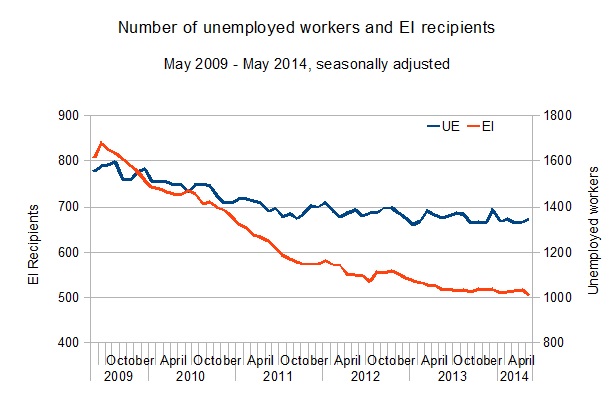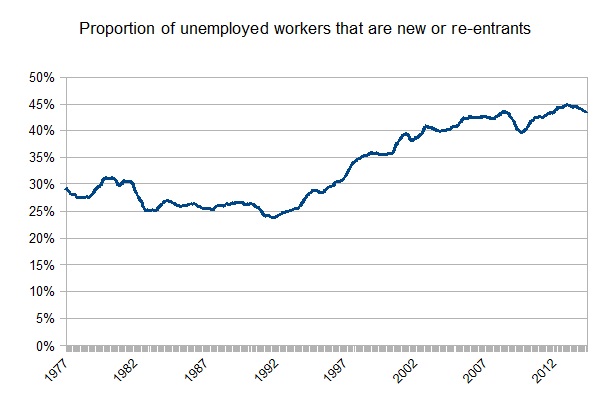EI Needs To Increase Access Not Lower Premiums
Erin does a nice job of documenting the fact that the number of EI recipients is falling, despite the fact that unemployment is rising.
But it seems to me that the crisis in EI is forever falling on deaf ears. Even though only 37.5% of unemployed workers are receiving EI, pundits and politicians feel that the problem with EI is not access, but high premiums. Improving access is usually not even presented as an option. If there’s a surplus in the EI Account, it must be that there is too much revenue, full stop.
Recent case in point. The Mowat Centre agrees with my assessment that the federal budget surplus is coming out of the annual EI surplus. But, they frame this in terms of premiums that are too high, ignoring the abysmally low proportion of unemployed workers that are receiving EI.
The difference is not a subtle one. In one case, the government is balancing the budget on the backs of unemployed workers by denying them benefits, and in the other case they are doing it on the backs of employers and employees (i.e. current contributors).
In the past year, the number of EI recipients has fallen 4x faster than the number of unemployed workers. That is, the number of unemployed workers fell by only 3,000 at the same time as the number of EI recipients fell by 12,000. The trend over the past five years is shown in the graph below. (Source for unemployment: CANSIM 282-0087, Source for Regular EI recipients: CANSIM 276-0022)
The red line is the number of EI recipients, and goes with the numbers on the left axis. The blue line is the number of unemployed workers, and goes with the numbers on the right axis.
Since May 2009, the number of unemployed workers has only fallen by 210,000 – or about 14% (so much for those million jobs Stephen Harper single-handedly created). The number of EI recipients has fallen by 300,000 – about 38% of the May 2009 amount. This shows up clearly on the graph above – proportionately, the number of EI recipients has fallen at two and half times the rate of unemployment.
While Federal Government program cuts, staffing cuts, and changes to appeals systems have made EI far stingier, simply reversing them doesn’t solve the problem. Labour market dynamics have evolved significantly even over the past 20 years or so. For example, in 1992, about 25% of unemployed workers were new entrants or re-entrants to the labour market. By 2012, that had risen to 45%. (Chart shows 12 month moving average, Source: CANSIM 282-0214).
In order to access EI, new labour market entrants and those that have not contributed to EI in the past two years must rack up at least 910 EI insurable hours in order to qualify for benefits or training supports. This is a giant barrier to a group of people who are most likely to make use of training and other supports offered through EI Part II.
Another issue is regional differences. Temporary and precarious urban workers (who are often racialized) face a much higher bar to entry than workers in regions with high unemployment rates. Urban workers often face many more barriers to secure employment than the regional unemployment rate conveys.
The only fair solution is a single national entrance requirement. A bar of 360 hours is equivalent to 30 hours per week for 12 weeks, which gets you in the door and able to access training benefits *if you lost your job through no fault of your own*.
The alternative is a deeply cynical one. If we say that premiums are too high, and current EI contributors are the victims of the government’s greedy tax grab, we’re also saying that it’s perfectly OK that only 37.5% of unemployed workers are receiving EI. We’re saying that it’s perfectly justifiable that the number of EI recipients are falling while the number of unemployed workers are increasing. We’re saying that it’s OK that EI access and EI training supports are out of reach for most of the 500,000 unemployed labour market entrants and re-entrants.
It’s not OK. No one who takes a minute to think of the people who are falling through the cracks could say that it even approaches OK. Stealing from the unemployed to deliver a balanced budget before the next election is pretty much the opposite of OK.



You have completely nailed it Angella